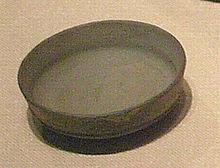Sue pottery
Sue pottery ( Japanese 須 恵 器 , Sue-ki , historical Kun reading : sue no utsuwa , German also "Sue-Ware") is a form of dark gray unglazed pottery that was used in Korea and Japan during the Kofun -, Nara - and Heian period was made and used. The name was derived from a reference in Man'yōshū in 1950 ; Until then it was called Iwaibe doki ( 祝 部 土 器 , literally: “Iwaibe earthenware ”) or Chōsen doki ( 朝鮮 土 器 , “Korean earthenware”), in the Nara and Heian times also generally with Tōki ( 陶器 , dt. such as "pottery").
overview
Ceramic goods of this kind were made with the technique of the "high-speed rotating disk" handed down from Korea. They were fired at 1100 ° C to 1200 ° C reducing in a " slope kiln " ( 登 り 窯 , noborigama ), which is why this ceramic was gray, in contrast to Haji ceramics ( 土 師 器 ), which was fired in an oxidizing manner and therefore had a reddish color owned.
Usually, large vessels for storage and everyday tableware such as bowls, bowls or stand bowls were made from Sue ceramics. In addition, the sturdy Sue pottery was also used as a ritual vessel and as a burial object . Since a large amount of Sue pottery was discovered as additions to barrows ( kofun ) from Kyūshū in southern Japan to Aomori in the north, it serves as a guide for the chronology and spread of ceramics in ancient Japan. The origin of Sue pottery is traced back to the Chinese Yangshao culture (5000 to 3000 BC). Ceramic production in China experienced a technological leap with the development of the potter's wheel in the Longshan culture (2500 to 2000 BC).
The Sue pottery probably came to Japan in the 4th century AD through the foreign policy relations between the "Kingdom of Wa" (Japan) and the Korean mainland. Archaeological excavations and findings show that the Gaya Confederation had ceramic production centers in Gimhae , Goryeong (Koryong) and Hapcheon (Hapch'on), which made products similar to Sue ceramics. Findings in Korea suggest that the Mahan and Baekje ceramics (3rd to 5th centuries) from Seoul to the coastal region of North Jeolla were associated with the Sue ceramics of the Wa and that a common technology and ceramic Cultural sphere existed.
literature
- Dawn time. Japan's archeology and history up to the first emperors . In: Alfried Wieczorek , Werner Steinaus, Research Institute for Cultural Goods Nara (Ed.): Publications of the Reiss-Engelhorn-Museums Volume 10 . 1. Catalog volume. Peschke Druck, Munich 2004, ISBN 3-927774-17-0 .
Individual evidence
- ↑ 祝 部 土 器 . In: デ ジ タ ル 版 日本人 名 大 辞典 + Plus at kotobank.jp. Retrieved September 12, 2013 (Japanese).
- ↑ a b c Kyoji Sakai: 4.6 Haji and Sue goods , in: Time of the Dawn. Volume 2, Handbuch, 2004, pp. 360-363
- ↑ Werner Steinhaus: Small dictionary on Japanese archeology - Japanese-German (= writings on Japanese archeology I ). epubli, Berlin 2010, ISBN 978-3-86931-803-5 , p. 109 : "ascending kiln, wood-fired slope kiln (early modern kiln)"
